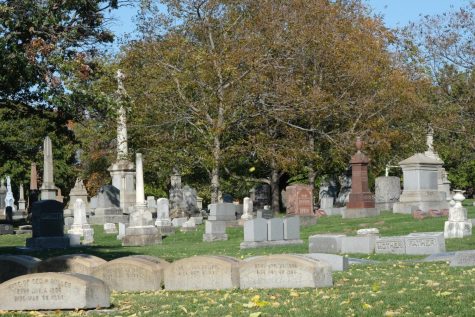A haunted guide to the second city
October 23, 2022
It really shouldn’t surprise anyone that Chicago has a plethora of haunted locations. Considering the history of this great city, there are plenty of tragedies and people that can lead to haunted connections such as catastrophes like the Chicago fire and the Eastland disaster. Then, there are the city icons like Al Capone and H.H. Holmes. There are three specific haunted locations that are particularly accessible to DePaul students. If you’re looking for a good spooky ambience, check out these paranormal spots.
The Congress Hotel
Built in 1893 in anticipation of the World’s Fair, The Congress Hotel has lots of haunted history. According to Time Out Chicago, it is the second-most haunted place in the city. H.H. Holmes, known as one of the first recorded serial killers, would loiter in the lobby of the Congress looking for new victims to lure back to his own hotel, also know as the “Murder Castle.”
Another frequent customer of this famous hotel was the notorious Chicago mobster, Al Capone. Most active in Chicago between 1925 and 1931, he would often use the Congress as his unofficial headquarters for “business meetings.” Many colleagues would enter the hotel with Capone and his crew but never come out.
Customers regularly complain about supernatural activity at the hotel, especially on the fourth floor. Check it out for yourself at 520 S. Michigan Avenue.
Couch Mausoleum
Built back when Lincoln Park was a mass cemetery for Chicago in the 1840s, the Couch Mausoleum is one of the only standing graves in Lincoln Park. It is one of the last standing structures that survived the Chicago Fire.
The story behind the Couch Mausoleum does not have the most horrific origin. James Couch had this mausoleum built for the Couch family in the 1850s right after his brother, Ira Couch died. Ira Couch and his brother owned multiple hotels across Chicago and were pretty successful. Couch died in 1857 while on vacation in Cuba, and his remains were sent back to be put in the mausoleum.
As the Couch family passed away, more members were put in the tomb. One of the mysteries around the tomb is why it got to stay up after all the bodies from the cemetery were relocated.

In the early 1900s, a city park district worker entered the tomb to do some work around it and claimed he saw nothing in the tomb — no bodies, just an empty mausoleum. When this information got around, Couch’s grandson spoke up. He claimed that seven family members should be in the mausoleum. These records are odd though, because the names that the grandson mentioned are buried on a Couch family plot in Rosehill cemetery, on the far northside of Chicago.
Some of the earliest Chicago ghost stories were reported surrounding this vault of death. It was said that if you go to the mausoleum right at midnight, large, white, ghostly figures would come out of the tomb and greet visitors. These urban legends still spread around the mausoleum to this day. If you are a DePaul student with nothing to do at midnight, take a stroll to the Couch Mausoleum.
Graceland Cemetery
Located in the Uptown neighborhood, this iconic Chicago cemetery holds plenty of history. Graceland Cemetery was built in 1860 just blocks away from Wrigleyville. At the time, that area of Chicago barely had any residents and felt more like a nature preserve.
There are multiple tombs there with spooky stories surrounding them.

One of the more mysterious tombs is the one built for Inez Clarke. She was born in 1873 and died in 1880. Her cause of death was never confirmed, but the two most frequent answers and reports are that she was struck by lightning on a picnic or got locked out of her home during a thunderstorm.
Due to both of those revolving around thunderstorms, it is said that the statue of her on her tomb disappears when it rains.
There have also been reports of seeing a ghostly little girl wandering around the cemetery, but she can only be seen by children.
For DePaul students that spend their nights out in Wrigleyville, try traveling a few more blocks north and give Inez a visit.
